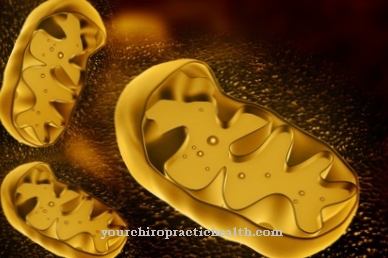In the involution embryogenesis is a basic movement of gastrulation. In addition, in medicine, involution often stands for the natural regression of tissue with age. In pathophysiology, a pathological regression of abilities and tissues is associated with this term.
What is the involution?

In medicine, the term involution is used to describe a degenerative process in which individual tissues or organs "shrink". Involution is an age-physiological process. For example, various organs are only active for a limited time and naturally regress after their active phase. This applies, for example, to the female uterus and the female mammary glands, which naturally regress after the birth of a child.
This definition differs from the embryological definition. In embryology, involution is a phase of gastrulation. During gastrulation, the so-called blastula turns inside out so that the three cotyledons develop. The bladder germ has previously formed in what is known as blastulation.
Involution is the second of five basic gastrulation movements. The prospective endoderm, i.e. a portion of the inner cotyledon, rolls up during involution.
Function & task
Involution has different meanings in medicine. The main meaning in applied medicine is that of natural and intended degeneration. In this context, tissue recedes during involution, which physiologically only needs to be active for a certain period of time.
During the involution of the voice, for example, the female voice drops after the postmenopause because of the now higher testosterone level. The testosterone enlarges the larynx so that the basic intonation when speaking is lowered.
From around the age of 40, the eyes are affected by an involution. The result is presbyopia, which is particularly noticeable when reading without glasses. Another form of involution is hearing loss, which gradually sets in from around the age of 20. Involutions of language also appear in aging people.
Due to natural cell loss in the extrapyramidal nervous system, the voice drops during pronunciation and the articulation becomes weaker. After cell losses in the pyramidal nervous system, there is also a slowdown in pronunciation. Word-finding disorders and mild dementia are also a natural involution from a physiological perspective.
Embryogenic involution, on the other hand, is a basic movement of gastrulation. During intussusception, the prospective endoderm invades into the inner cavity of the blastula, known as the blastocoel, as part of gastrulation. Part of the outer wall is turned inside out due to cell deformation. This process is followed by involution, in which the prospective endoderm curls up. Then the ingression takes place in the sense of a cell invasion of the prospective endoderm.
During the subsequent delamination, blastula cells bind cells of the endoderm into the blastocoel. During the last movement, the epibolism, the prospective ectoderm overgrows the prospective endoderm in yolk-rich eggs.
Illnesses & ailments
Disturbances in embryogenic involution can result in malformations or even cause the child to pass away. From the beginning of gastrulation, the embryo is extremely sensitive to pollutants. Gastrulation disorders can correspond to sirenomelia or coccyx teratomas, for example. In addition, extremities that have grown together, anomalies of the spine, missing kidneys or malformed genital organs can be due to gastrulatory disorders. Gastrulation disorders are often associated with neurulation disorders, as the two phases sometimes overlap towards the end of gastrulation.
Involution has many other associations from pathophysiology and does not necessarily have to be meant in the embryological sense in connection with diseases. An association from pathophysiology is, for example, pathological dementia, as it can occur in the context of Alzheimer's, but also in the context of alcoholism or Parkinson's. Aphasia in the sense of a pathological loss of speech is also typical for these diseases and corresponds in the broadest sense to a pathological involution.
Since all of the symptoms mentioned are, to a certain extent, natural age phenomena of involution, diagnosis is more or less difficult. In order to distinguish a natural involution of language and memory from a pathological phenomenon, various diagnostic agents are available. In this case, the most reliable and standard diagnostic agent is a so-called screening using comprehensive standard tests. In the German-speaking world, the most common test for such a screening is the cognitive minimal screening. In addition, the CAMDEX from the English-speaking area is now available in Germany. The standard test was developed in Cambridge and measures not only the linguistic intelligence but also the non-verbal intelligence of older people in order to be able to better assess involutions.
The early diagnosis of degenerative diseases such as Alzheimer's and Parkinson's should not be underestimated for several reasons. Practicing methods can, for example, delay the course of the disease if Alzheimer's or Parkinson's disease is recognized. In addition, drugs are now able to almost bring the course of the disease to a standstill or at least slow it down for many years.












.jpg)



.jpg)










.jpg)
